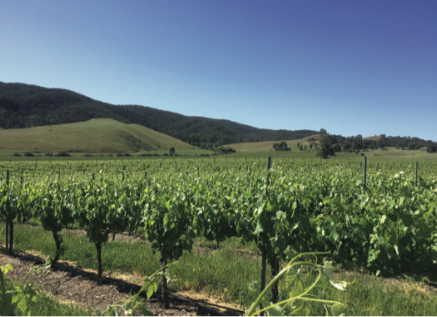By Sam Scott, Scott Wines, Adelaide Hills, South Australia
First published in the September/October 2016 issue of the Wine & Viticulture Journal

 Fiano is certainly a white grape variety for our future. It reflects the evolving culture of how we use wine; more is consumed at the table, it is a foodie wine, and it has the adaptability to thrive in our changing climate with crazy variable vintages and extreme weather events. It also suits our soils and complements our lifestyle.
Fiano is certainly a white grape variety for our future. It reflects the evolving culture of how we use wine; more is consumed at the table, it is a foodie wine, and it has the adaptability to thrive in our changing climate with crazy variable vintages and extreme weather events. It also suits our soils and complements our lifestyle.
The inherent characteristics of Fiano, wherever it is grown, are its textural and savoury palate, trademark pithy phenolic grip, chalky minerality and medium to full flavours often featuring citrus, hazelnuts, florals and spice. The warmer years and/or regions can show waxiness to the palate while cooler years and/or regions can produce greater citrus characters. It lends itself to making different styles of wine too, ranging from steely Riesling-esque wines to full-bodied textural, rich wines.
Fiano was pioneered in Australia, by Mark Lloyd of Coriole, in McLaren Vale, and the Chalmers Nursery, Mildura. It first appeared in Australia in 1978 at the CSIRO and sat around in a cool room until the early 2000s when an enquiry from Mark Lloyd, who had just returned from a scouting mission in Italy searching for white varieties with great potential for McLaren Vale, got the ball rolling. Both Coriole and the Chalmers family made wine from Fiano for the first time in 2005.
It is a hardy, thick-skinned, loose-bunched grape that loves heat and sunshine yet can handle wet and humid conditions. So it is an all-rounder. This is epitomised by the range of regions and conditions where you will find it grown in Australia. In diminishing order of vineyard area it is found in the Murray Darling, Riverland, Clare Valley, Langhorne Creek, Adelaide Hills, Hunter Valley, King Valley, Barossa Valley, Riverina, McLaren Vale, Great Southern, Margaret River and then, in no particular order, Heathcote, Rutherglen, Bendigo, Griffith, Coonabarrabran, Fleurieu Peninsula, Geelong, Sunbury, Avoca, Swan Hill and the Alpine Valleys. There are also wines appearing in California, USA and Mendoza, Argentina.
Fiano ticks many boxes. As already mentioned, it grows well, tastes great, consumers like (love!) the flavours (particularly as palates mature/move on from overt varieties) and it can be pronounced without embarrassment!
It has many key viticultural advantages including very good resistance to disease (with the exception of being prone to powdery mildew), great acid retention even in extreme heat, moderate vigour, manageable semi-upright habit, achieves a good canopy early, and medium size bunches with loose berries and thick skins. The things to watch out for are powdery mildew, a second crop and clumping in the bunch zone when spur pruned.
During our search for a textural and savoury grape variety, Fiano just happened to be the variety that popped up on our radar. Caj and Genny Amadio had planted a pilot block of six short rows in 2005 at their visionary Amadio Vineyard at Kersbrook and I was fortunate enough to snap it up in 2009. Subsequently, more vines have been either planted or grafted to Fiano in their vineyard. We have been making Fiano under our Scott wines label since 2010 and in 2015 we re-branded the Scott Fiano into our specialist Italian variety range, La Prova.
The Amadio Vineyard at Kersbrook, in the northern Adelaide Hills, has an elevation of 250-300m and an annual rainfall of 550-650mm. The soils are predominantly well-drained grey loamy sands, with a topsoil of mottled yellow and red medium clay subsoil.
We take fruit from three blocks of vineyard which are all planted to SAVII 01 with a row and vine spacing of 2.7m x 1.5m, respectively.
The pilot block and the 1ha block of Fiano (which is grafted onto 1997 Chardonnay roots) resembles a Winter Olympics ski-jump and has an easterly aspect. The vines are trained to a single wire VSP and spur pruned to two buds with a decent hand spacing between them, leaving four more buds per vine at the bottom of the hill as it is more vigorous. The third block we take fruit from has a northerly aspect and is on deeper red sandy loam. We have been trialling cane pruning in this block and wrapping four canes onto two cordon wires to good effect for an open canopy, a consistent 9-10 tonne/ha (compared with 8-9t/ha with spur pruning), well-distributed bunches and a reduced need for shoot thinning.
All blocks are shoot thinned early to open up the canopy, allowing light penetration into the bunch zone and increasing air movement to reduce powdery mildew pressure. With two wire lifts we aim to catch more shoots on the morning sun side of the canopy and leave more shoots out in a Lazy Ballerina fashion on the afternoon sun side. Fiano seems to love getting sun-kissed and bronze, but in heatwave years direct afternoon sun exposure does shrivel some bunches, so more protection on that side is good. Once again, trimming is tight on the morning side, less so on the afternoon side. In some years a bunch thin is required to reduce clumping (or yield) and in extreme conditions, like the wet 2011 season, basal leaf removal was employed for maximum sunlight penetration and airflow.
While it handles heat, even extreme heat, very well it does require available soil moisture, so top up irrigation shifts are scheduled if there has not been adequate rainfall. And in extreme heat, two 30L/vine/week shifts are applied to maintain leaf function.
Harvest typically begins just after Shiraz has finished in the third to fourth week of March. The earliest harvest on record occurred in the hot and dry 2016 vintage when picking began in the third week of February. The latest fruit to come off was in the cool, wet 2011 vintage when the ‘ski-jump’ was picked at the end of April. The cooler easterly slope of this ‘ski-jump’ block ripens seven to 14 days later than the blocks with more sun exposure.
The picking decision is triggered by flavour, when hard greenness dissipates and sherbet starts to move in. Flavour accumulates slowly and, except in unusually hot and dry years, you do not feel pushed into picking, as the sugars move at a sedate pace. A typical juice analysis will range from 12-12.8 Baume, 3.00-3.25pH and 7.0-8.5TA.
We handpick the fruit as a preference and chill it overnight before whole bunch pressing. I find this dials in a nice pithy grip to the free run juice. With the hard pressings we fine and hyper-oxidise the juice. In 2016 we crushed and destemmed to the press due to the very small berry sizes, when whole bunching would not have yielded any juice. Both methods have given good results. Experiments with skin contact of six to 12 hours have revealed a lovely fresh pithy palate with a greater spice component while after several days the spice moves to heady clove/spice aromas and flavours.
Between 20-40% of the juice is run straight off the press tray for a full solids wild ferment in old French oak. The balance is cold settled then racked with the fluffy lees to tank for fermentation where it is inoculated with QA23. The barrel ferments look so good that each year this component has been increasing.
The wine sits on lees until June/July when it is blended, stabilised and bottled.
REFERENCES
Chalmers, K. (2016) pers. comm.
Halliday, J. (2015) Varietal Wines: A guide to 130 varieties grown in Australia and their place in the international wine landscape. Hardie Grant.
Lloyd, M. (2016) pers. comm.
Robinson, J.; Harding, J. and Vouillamoz, J. (2012) Wine Grapes: a complete guide to 1,368 vine varieties, including their origin and flavours. Penguin Group.
Tassie, L.; Dry, P. and Essling, M. (2010) Alternative varieties: emerging options for a changing environment. AWRI Research to Practice workshop.
Fiano

By Peter Dry Emeritus Fellow, The Australian Wine Research Institute
BACKGROUND
Fiano (fee-AH-no) is an old variety from Campania (southern Italy), recorded as early as the 13th century. It is best known in the DOCG Fiano di Avellino. In the past it was not widely grown despite a good reputation for wine. Since the 1970s it has had a modest revival and the planted area has expanded. It is seen throughout Campania and also grown in parts of Basilicata and the Marche. There are relatively recent plantings in Sicily (more than 250ha). The global area in 2010 was 1377ha, most of which is in Italy. Synonyms include Apiana, Apiano, Fiana, Fiore Mendillo and Foiano. DNA analysis has shown the variety grown in Puglia named Fiano Aromatico or Fiano di Puglia is distinct from Fiano (di Avellino) and there is a proposal to rename the former as Minutolo. In Australia, there are 111ha at present and the tonnage has doubled since 2012. There are currently more than 50 wine producers, mainly in McLaren Vale, Adelaide Hills, Riverland and Barossa Valley.
VITICULTURE
Budburst is mid-season and maturity is mid-season (relatively late for a white variety and similar to Shiraz at McLaren Vale). Vigour is moderate to high and growth habit is semi-erect. Bunches are small to medium, well-filled with small to medium thick-skinned berries. Yield is moderate. Spur pruning is used in Australia but cane pruning is used in Italy. In Australia, Fiano has average susceptibility to mildews. Risk of bunch rot is low. Fruit hangs well on the vine and has good acid retention. Fiano has proven to be one of the best new varieties for warm to hot climates.
WINE
Fiano wines are fresh, well-structured with attractive texture and good natural acidity. Descriptors include pear, lime, lemon peel, melon, hazelnut and spices. In Italy, Fiano is used for both varietal wines, e.g., DOCG Fiano di Avellino, or as a blending component in DOCs such as Irpinia and Sannio. Fiano can be used for a range of wine styles with excellent consumer acceptance.



















